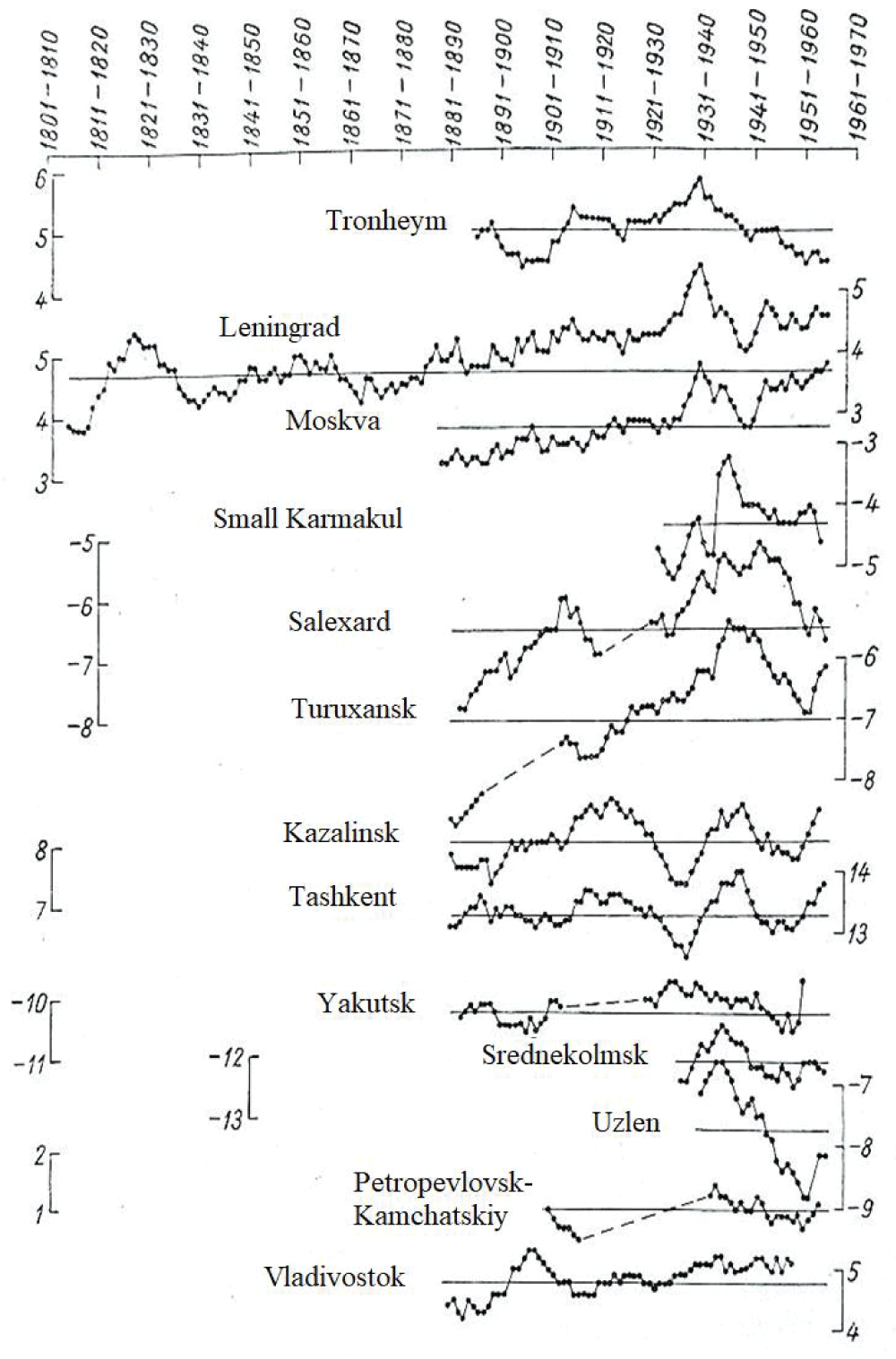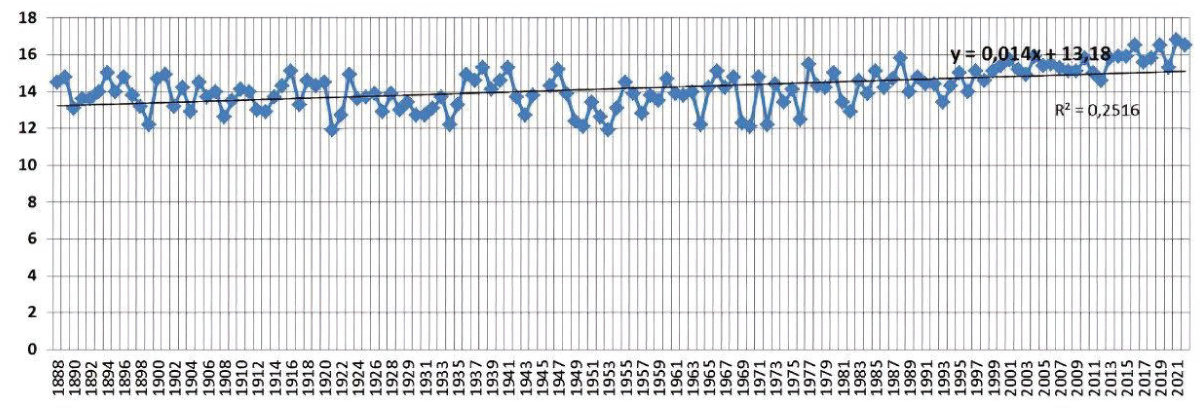
About the Problem of Climate Warming
Environmental Contamination Environmental ImpactsEnvironmental SciencesReceived 21 Oct 2024 Accepted 12 Nov 2024 Published online 13 Nov 2024
ISSN: 2995-8067 | Quick Google Scholar
Next Full Text
Knowledge Discovery on Artificial Intelligence and Physical Therapy: Document Mining Analysis


Received 21 Oct 2024 Accepted 12 Nov 2024 Published online 13 Nov 2024
The article criticizes studies on modern warming that do not take into account the warming of the last interglacial period—the Holocene. According to data from numerous meteorological stations, no anthropogenic contribution to climate warming is detected before 1950. This contribution becomes noticeable in the meteorological station data after 1950.
Currently, although it may not be humanity's foremost problem, global climate warming ranks as the second most pressing issue. It draws significant attention not only from scientists and specialists but also from public figures and leaders of nearly every country, including major nations such as China, the USA, and Russia. Extensive research on climate change is being conducted at both global and regional levels, with efforts focused on identifying its causes and consequences, often involving substantial expenditures. Notable progress has been made in the use of solar and wind energy [,], biofuels and expanding areas dedicated to green energy [,]. Other advancements include enhanced CO₂ deposition in oceans, the development of geothermal energy, and the initiation of hydrogen as a clean energy source. The number of nuclear power plants is also rising.
Climate summits often host around 5,000 participants, including top leaders from various nations, with each summit costing taxpayers approximately 15 million dollars. Despite these efforts, significant success in mitigating climate warming has not yet been achieved.
One major reason for the unsatisfactory results in climate warming research is the lack of consideration for global warming events at the end of the Quaternary period. For example, Figure 1, adapted from [], shows that climate warming was not recorded over the last millennium, with rapid increases in air temperature only beginning at the start of the 20th century.
In reality, global warming began with the onset of the last interglacial period—the Holocene—which continues to the present, when natural warming has reached its peak.
It is noteworthy that during the 14th and 15th centuries, global warming was interrupted by the Little Ice Age [], most likely due to glacier formation and dynamics.
Over the past two centuries, climate warming has been analyzed using data from stationary meteorological stations worldwide []. From these data, chronological graphs have been compiled, illustrating changes in various air temperature indicators from 1800 to 1950. Figure 2 presents such a graph of average annual air temperature based on data from meteorological stations in the former USSR.
The authors of this study have compiled similar graphs for nearly all meteorological stations across all continents, with most showing a positive temperature trend until the mid-20th century.
"It is important to note that air temperature undergoes multi-year fluctuations of varying duration and amplitude, which are generally synchronous over the entire observation period across large regions in the high and temperate latitudes of the Northern Hemisphere. However, the period of instrumental observations is too short to assess the maximum wavelengths of these fluctuations" [].
The onset of anthropogenic influence on the climate is generally considered to have begun around 1910. In the subsequent period, overall warming needs to be separated into natural and anthropogenic components — a challenging task.
Figure 3 displays a chronological graph of the average annual air temperature in Tashkent from 1880 to 2021, showing an upward trend beginning in the mid-20th century. According to meteorological data from Namangan, the average annual air temperature from 1880 to 1945 exhibited a slight increase, with a trend of 0.013 °C from 1945 to 1975, and 0.03 °C from 1976 to 2021. These data suggest that the anthropogenic rise in average annual temperature began in the latter half of the 20th century.
As evident, the warming trend is significant and concerning. Notably, the Namangan meteorological station is situated in the Fergana Valley, encircled by high mountain ranges, which provides some protection from major natural shocks. Additionally, the data highlight the inadequacy in the pace of transition to environmentally friendly energy sources. Instead, coal production and consumption have sharply increased.
Before 2000, coal consumption did not exceed 4 billion tons annually; however, in recent years, it has consistently remained above 8 billion tons []. With such high levels of coal combustion—the primary source of atmospheric CO₂ emissions—it is unrealistic to expect climate warming to be effectively curbed.
In conclusion, it is worth noting that at the start of the last interglacial period of the Holocene, aphelion occurred in winter and perihelion in summer, a configuration opposite to the present period.
Jabeen S, Malik S, Khan S, Khan N, Qureshi MI, Saad MSM. A comparative systematic literature review and bibliometric analysis on sustainability of renewable energy sources. Int J Energy Econ Policy. 2021;11(1):270-280. doi:10.32479/ijeep.10759.
Koriyev MR, Abdujabborov AA. Alternative energy resources of Uzbekistan and possibilities of their effective use. Dera Natung Government College Res J. 2022;7(1):20-31.
Kauppi PE, et al. Managing existing forests can mitigate climate change. Forest Ecol Manag. Tashkent. 2022:120-186.
Ososkova TA, Spektorman TY, Chub VE. Climate change. UNEP. Tashkent. 2005:54.
Treshnikov AF, editor. Geographic Encyclopedic Dictionary: Concepts and Terms. Moscow: Soviet Encyclopedia. 1988; 432.
Rubinstein ES, Polozova LG. Contemporary Climate Change. Leningrad: Hydrometeorological Publishing House. 1966; 268.
Kamalov BA. The relationship between energy and climate warming. Int J IgMin Res. 2024 Jun 7;2(6):413-415. doi:10.61927/igmin194.
Asomovich KA. About the Problem of Climate Warming. IgMin Res. November 13, 2024; 2(11): 926-928. IgMin ID: igmin269; DOI:10.61927/igmin269; Available at: igmin.link/p269
Anyone you share the following link with will be able to read this content:
Address Correspondence:
Kamalov Bakhodir Asomovich, Doctor of Geographical Sciences, Professor, Namangan State University, Uzbekistan, Email: [email protected]
How to cite this article:
Asomovich KA. About the Problem of Climate Warming. IgMin Res. November 13, 2024; 2(11): 926-928. IgMin ID: igmin269; DOI:10.61927/igmin269; Available at: igmin.link/p269
Copyright: © 2024 Asomovich KB This is an open access article distributed under the Creative Commons Attribution License, which permits unrestricted use, distribution, and reproduction in any medium, provided the original work is properly cited.
![Changes in the average annual air temperature of the Northern Hemisphere [4].](https://www.igminresearch.com/articles/figures/igmin269/igmin269.g001.png) Figure 1: Changes in the average annual air temperature of t...
Figure 1: Changes in the average annual air temperature of t...
 Figure 2: Moving 10-year average temperatures, years....
Figure 2: Moving 10-year average temperatures, years....
 Figure 3: Average annual air temperature at the Tashkent obs...
Figure 3: Average annual air temperature at the Tashkent obs...
Jabeen S, Malik S, Khan S, Khan N, Qureshi MI, Saad MSM. A comparative systematic literature review and bibliometric analysis on sustainability of renewable energy sources. Int J Energy Econ Policy. 2021;11(1):270-280. doi:10.32479/ijeep.10759.
Koriyev MR, Abdujabborov AA. Alternative energy resources of Uzbekistan and possibilities of their effective use. Dera Natung Government College Res J. 2022;7(1):20-31.
Kauppi PE, et al. Managing existing forests can mitigate climate change. Forest Ecol Manag. Tashkent. 2022:120-186.
Ososkova TA, Spektorman TY, Chub VE. Climate change. UNEP. Tashkent. 2005:54.
Treshnikov AF, editor. Geographic Encyclopedic Dictionary: Concepts and Terms. Moscow: Soviet Encyclopedia. 1988; 432.
Rubinstein ES, Polozova LG. Contemporary Climate Change. Leningrad: Hydrometeorological Publishing House. 1966; 268.
Kamalov BA. The relationship between energy and climate warming. Int J IgMin Res. 2024 Jun 7;2(6):413-415. doi:10.61927/igmin194.